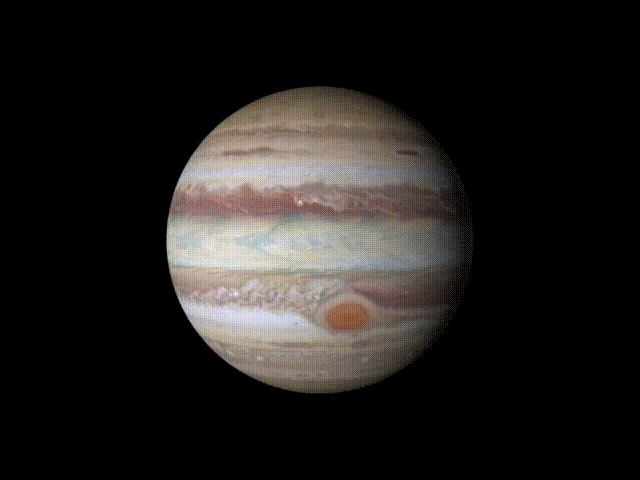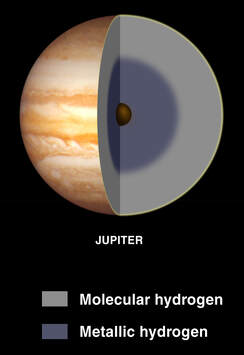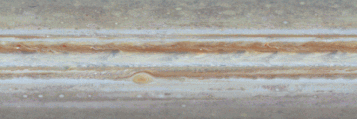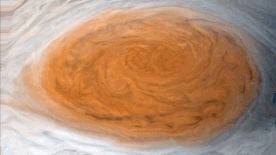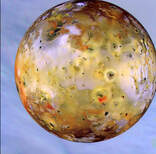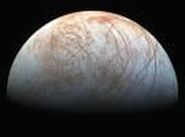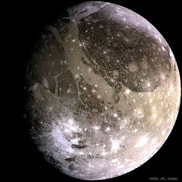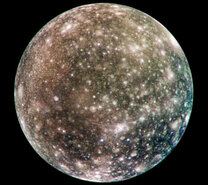JUPITER
|
Formation Jupiter is thought to be the oldest of the planets. It formed from gases remaining in the solar nebula, following the Sun's formation 4.5 billion years ago. Jupiter became the largest planet in the Solar System by far. It has more than double the mass of all the other planets put together. It is a gas giant, and not surprisingly, it is made of the same two gases as the Sun- hydrogen and helium.
Jupiter likely formed closer to the Sun and then migrated to its current orbit about 4 billion years ago. Because of its enormous mass, it is possible that Jupiter influenced both the formation and the orbits of the inner terrestrial planets. Though Jupiter is the largest planet in the Solar System, it has the shortest day- only 9 hours 53 minutes. |
|
Structure, Atmosphere and Magnetoshpere Jupiter is one of the four gas giant planets, composed mostly of atmospheric and compressed gases. It likely has a small, solid core, equal to 1-2 Earth masses. Whether this core is truly “solid” or "diffuse", mixing with the over-laying mantel, is currently undecided.
Jupiter's upper atmosphere consists mostly of hydrogen (90%) and helium (10%) with traces of other elements (methane, water vapor and ammonia). Toward the interior the gravitational and atmospheric pressure converts the gaseous atmosphere to a liquid. At depths of more than 10,000 km, the liquid hydrogen’s electrons are freed, and the hydrogen behaves like a metallic conductor of electricity (“metallic hydrogen”). Jupiter’s interior temperature is estimated to be approximately 20,000 degrees K- much hotter than the surface of the Sun. The source of this heat is not well understood. It may be the result of ongoing contraction of the planet under its extreme gravity. |
|
Jupiter has the deepest atmosphere of any planet in our Solar System- over 5,000 km. in altitude. By comparison, the Earth's atmosphere is 100 km high, and the International Space Station orbits the Earth at an altitude of about 350km.
Jupiter's upper cloud deck is about 50 km. thick, showing several distinct light and tawny-coloured bands. The light-coloured bands are comprised of water and ammonia ice; the tawny-coloured bands are thought to be convection cells rising from the warmer interior and carrying compounds such as phosphorus, sulfur and hydrocarbons. This region is highly electrically charged, producing lightning that is 1000 times more powerful than that seen on Earth. |
|
The “Great Red Spot” is a massive storm, akin to a hurricane on Earth. Wind speed is estimated to be 430-680 km/h. It is larger than the entire Earth, and was first observed more than 300 years ago. The rotational period is about 6 Earth days, and it appears to be decreasing in size. Occasionally, there are smaller dynamic weather systems nearby.
|
Jupiter’s magnetic field is 14 times stronger than Earth’s. It is thought to be caused by eddy currents in Jupiter’s metallic hydrogen interior. All of Jupiter’s major moons orbit within the magnetosphere. The solar wind causes a long tail in the magnetosphere on the lee side of Jupiter, which extends nearly to the orbit of Saturn. It is the largest structure in the Solar System. The strong magnetism surrounding Jupiter traps and accelerates charged particles, resulting in intense radiation belts which are hazardous to spacecraft.
Moons Jupiter has a total of 95 known moons (as of 2023). The four largest are called the Galilean moons - Io, Europa, Ganymede and Callisto. Their first verified observation was by Galileo in 1610 using the newly-invented telescope; however, it is possible Ganymede was observed in 362 BCE by Chinese astronomer Gan De. Galileo’s observation dealt a serious blow to the belief in a universe where all celestial objects orbited around the Earth. The Galilean moons change their positions on a nightly basis. They can be seen with any small telescope and most binoculars.
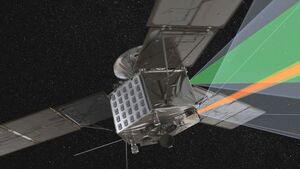
Missions There have been nine NASA-led missions to Jupiter: Pioneer 10&11, Voyager 1&2, Galileo, Ulysses, the Cassini-Huygens probe (with ESA and ASI), New Horizons, and Juno. Only Galileo and Juno were orbital missions, while the rest were flybys. The Galileo mission entered orbit in 1995, conducting multiple flybys of the Galilean Moons as well as making many observations of the planet, including the impact of comet Shoemaker-Levy 9. The Juno spacecraft (shown) arrived in 2016 and is budgeted until 2025. It is intended to study Jupiter's composition, its atmosphere, magnetosphere, mass distribution and gravity.

